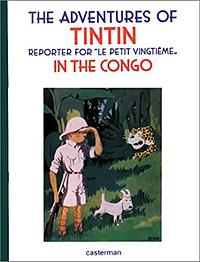You need to sign in or sign up before continuing.
Take a photo of a barcode or cover
Los estoy releyendo por primera vez desde que era un crio. A parte de ser hijo de su época mostrando racismo y colianismo es que es muy repetitivo. Misma trama cada diez paginas cambiando “X”. No tenia buen recuerdo de el pero ahora muchísimo peor.
This looks and flows (mostly) like any other Tintin story, but it is the worst of anything Hergè has ever given us in the name of Tintin. This is one of the most racist and pro-bloodsports comics I have ever read. Every black person is portrayed in the most offensive way you could portray a black person (e.g. drawn like blackface simians, stupid, prone to anger, deeply fascinated with white culture to the point of almost believing we are magic with our advancements, bloodthirsty, and more). Also, this book is more than okay with portraying animals as less than worthy of the same respect afforded to humans given how many of them Tintin attempts to hunt (and sometimes succeeds in killing). The least bad thing about this is that it’s a BAD Tintin story independent of the other things I mentioned, because there is no overarching plot to speak of and is essentially a series of barely connected misadventures that Tintin finds himself in at any given moment. It is such a shame that this book is connected to the following book, Tintin in America, via a direct connection with Al Capone. That book also isn’t great and has nearly identical levels of racism concerning First Nations people, but at least that book is able to be enjoyed in spite of its problems.
I do forgive this book for being the way it is for two reasons, however. One is that realizing Hergè has the attitudes he did because he was Belgian, which is an important historical note. When Africa was vastly colonized by most of Europe, the Belgians were among the worst to do so and treated Africans as less than human and had disgusting views. Knowing that shows that Hergè was a product of his time and his racism was racism born out of ignorance, not hate. The second reason is because Hergè became a more well traveled person because of the international success of Tintin and ended up deeply regretting all he had wrought in this comic because he worked for a publication that was conservative and Roman Catholic to the point of fascism. He later became as racially loving and open as a person could become and also became an opponent of bloodsport involving animals. So at the very least, he made amends by changing as a person, owing what happens here to mistakes of youth. That’s heartening and relieving to hear and is incredibly important to mention, but it’s not enough for me to not trash this book for what it did.
I do forgive this book for being the way it is for two reasons, however. One is that realizing Hergè has the attitudes he did because he was Belgian, which is an important historical note. When Africa was vastly colonized by most of Europe, the Belgians were among the worst to do so and treated Africans as less than human and had disgusting views. Knowing that shows that Hergè was a product of his time and his racism was racism born out of ignorance, not hate. The second reason is because Hergè became a more well traveled person because of the international success of Tintin and ended up deeply regretting all he had wrought in this comic because he worked for a publication that was conservative and Roman Catholic to the point of fascism. He later became as racially loving and open as a person could become and also became an opponent of bloodsport involving animals. So at the very least, he made amends by changing as a person, owing what happens here to mistakes of youth. That’s heartening and relieving to hear and is incredibly important to mention, but it’s not enough for me to not trash this book for what it did.
A notorious book, with inexcusably racist rendering of African characters that "reflects the prejudices of its time" doesn't cover. Hergé was capable of drawing non-Europeans with adequate sensitivity such that his subjects didn't appear subhuman. The big game hunting, ivory trading and casual animal killing may have been more palatable to readers when it was written. The artistry and narrative are a major leap forward from the first volume, and while I swear I had read this back in the 80s, it apparently wasn't available in English before 1991. Oh well; not for kids, but it should be included in the canon of Tintin adventures for completists.
adventurous
fast-paced
Plot or Character Driven:
Character
Strong character development:
No
Loveable characters:
Complicated
Diverse cast of characters:
Complicated
Flaws of characters a main focus:
No
Avec « Tintin au pays des Soviets » ainsi que « Tintin en Amérique », les trois premiers livres de Tintin ne se résistent pas justement l’épreuve du temps. L’esprit de l’écriture d’Hergé est présent partout la BD, mais couvert de couches du racisme flagrant. Gardez votre temps pour les autres œuvres d’Hergé en plupart des cas, mais si on veut un compréhension holistique de Tintin pour les raisons académique, critique, etc (comme j’ai fait)., Je vous invite.
Graphic: Racism
Moderate: Colonisation
Yeek. I was flinching too much at the racism to get into the plot.
J’aime beaucoup Tintin. Mais celui là est problématique: l’accent des africains, la façon infantilisante qu’a tintin en s’adressant à eux, …
adventurous
lighthearted
fast-paced
Plot or Character Driven:
Plot
Strong character development:
No
Flaws of characters a main focus:
No
Tintti -sarjan toinen osa sijoittuu Afrikkaan. Tai tarkemmin Belgian alaisuudessa olleeseen Kongoon, joka oli sarjakuvan ilmestymisaikaa Belgian siirtomaa.
Ja kyllähän se näkyi tässä kirjassa
Ja kyllähän se näkyi tässä kirjassa




